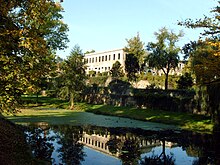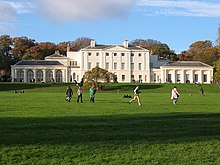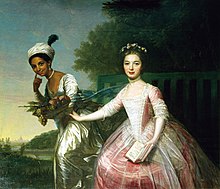|
Lady Elizabeth Finch-Hatton
Lady Elizabeth Mary Finch-Hatton (née Murray; 18 May 1760 – 1 June 1825) was a British aristocrat and the subject of a notable painting, once thought to be by Johann Zoffany,[1] now attributed to David Martin.[2][3] Early life Murray was born on 18 May 1760 in Warsaw, Poland-Lithuania. She was the daughter of David Murray, 2nd Earl of Mansfield, by his first marriage to German Imperial Countess Henrietta Frederika von Bünau. Her maternal grandfather was Count Heinrich von Bünau. It was when her father was an ambassador to the Elector of Saxony in Dresden, that he (by then 7th Viscount Stormont) met the beautiful Countess Henrietta, daughter of Imperial Count Heinrich von Bünau.[4]  They went on to be married on 16 August 1759 in Warsaw, Poland. It was a love match, Lord Mansfield himself approved and encouraged his nephew and heir on his courtship. Even though Countess Henrietta was very wealthy, their marriage was unusual for a rising politician, by choosing to marry a foreign noblewoman, Stormont had forsaken the opportunity to gain more social and political connections from a British marriage like his uncle, instead his marriage was based purely upon romantic affection.[5] During Stormont's embassy in Vienna, the role of an Ambassador's wife was significant, Countess Henrietta was a German-Saxon noblewoman therefore she could hold her own salon, which she did with considerable aplomb. Her father Count von Bünau had been an Imperial diplomat and was remembered in Vienna, therefore guaranteed Henrietta's own integration to the high society of Habsburg capital. The countess was a woman of enormous charm which captivated Prince Kaunitz, this made up for the relatively reserved manner of her husband. Prince Kaunitz was the most powerful State Chancellor and close advisor to Empress Maria Theresa, therefore the Countess helped secure her husband's admission to the private circle of the Habsburg ruling family, this made Viscount Stormont's embassy to Vienna a huge success.[6][5] The couple had two children, Lady Elizabeth and Henrietta, the younger sister was born in Dresden but sadly died young in Vienna, followed closely by their mother Countess Henrietta, who died on 16 March 1766 in Vienna at the age of just 29. She was interred at Viennese prostestant church, but her heart was removed and encased in a golden vase which accompanied the Viscount everywhere he went and later the gold vase was taken to his ancestral seat Scone Palace.[4][7][5] After the death of her mother in 1766, her father Viscount Stormont had a traumatic nervous breakdown and given extended leave of absence, the love of his life had died and now he was left a single parent, however due to his ambassadorial occupation and state of mind, he was not able to give Elizabeth a stable upbringing or care, so he arranged for Elizabeth to be brought up in England by his childless uncle William Murray, 1st Earl of Mansfield and his wife at Kenwood House. Stormont's unmarried sister Lady Anne would also come to help raise her niece, later Lord Mansfield would also take in his other great-niece brought from the West Indies Dido Belle.[7][8] Kenwood HouseLady Elizabeth Murray was six when she entered the care of her father's uncle the Earl of Mansfield at Kenwood, Hampstead. Her father Viscount Stormont was to inherit his uncle's title and entire wealth including Kenwood House. She was joined shortly by her illegitimate second cousin Dido Belle. It may have been possible that Lord Mansfield took Dido in order to give Elizabeth a playmate, as they were around the same age. While it is known that Belle had responsibility of managing the dairy and poultry yards and do menial tasks for her Great Uncle, as this was typical for women of the gentry, but many doubt that Lady Elizabeth has anything to do with dairy or poultry yards.[8]  In 1766, one of two unmarried sisters of Viscount Stormont and aunt to Lady Elizabeth, Lady Anne Murray (1730–1817) would come to live at Kenwood at the same time as Elizabeth and Dido, they all were joined at a later date by the second sister Lady Marjory (1730–1799) before Lady Mansfield's death.[9] Lady Elizabeth received £100 while Dido received £20 yearly allowance from their great uncle. The disparity may have arisen because of Dido's race and illegitimacy, but Lady Elizabeth possibly received more because her father was Mansfield's heir.[7] Dido Belle and Lady Elizabeth had a close bond during their time at Kenwood, their bond was noted by an American visitor Thomas Hutchinson to Kenwood in 1779, around the time their portrait was painted by David Martin.[10] Lord Mansfield had a particular affection for Lady Elizabeth, he would take her riding to visit neighbours.[11] In 1778, Boscawen wrote that she had received an exceeding honor when Lord Mansfield rode with Miss Eliza Murray to pay her a visit. After the visit, Lord Mansfield remounted his palfrey with "his fair niece" and went back to Kenwood, but not long a heavy shower fell which caused Boscawen great disturbance, but "Miss E Murray was so good to write me that they escaped the rain".[12] Ten years after her mother's death, her father Viscount Stormont remarried for a second time to Louisa Cathcart, daughter of Lord Cathcart on 6 May 1776.[13] Lady Elizabeth's father often visited her and she also regularly visited her father and her stepmother at Wandsworth and at their London home, as a couple of letters have been found, in which she wrote to Mary Hamilton about the birth of Louisa's 3rd son, Charles. Elizabeth also referred to her stepmother as "our dear Lady Stormont" indicating a warm relationship between stepmother and stepdaughter. Elizabeth would write more letters from Kenwood and Wandsworth to Mary Hamilton (Louisa's cousin and close friend).[8] Her father had wanted to bring Lady Elizabeth to Paris where he was the ambassador, but "Lady Mansfield won't hear of letting her go with us, which I regret exceedingly." [14] On March 1778, France declared support for American Revolutionary War against the British, and the ambassadors to both countries were hastily recalled. Lord Stormont returned back to England at the end of March, just in time for Elizabeth's 18th Birthday in May.[15] On 7 August 1784 Mary Hamilton visited Kenwood and provided a glimpse into how she viewed Lady Elizabeth:
Royal BallsIn the spring of 1784, The Prince of Wales begged Mary Hamilton's uncle to invite her to attend a royal ball at Carlton house, to which Lady Stormont was also invited. On the day of the ball, 10 March, Hamilton wrote in her diary that her cousin Lady Stormont had invited her stepdaughter Lady Elizabeth, Elizabeth was also present when Lady Stormont picked up Hamilton on the way to the ball in her carriage. They arrived at the ball together and were greeted right away by the Prince. Although Lady Elizabeth was invited, Dido Belle evidently wasn't invited.[16][17] Elizabeth's father Lord Stormont was a prominent aristocrat and would regularly invite Elizabeth to court functions and Royal balls. On 18 January 1781, Lord Mansfield, Lord Stormont, and Elizabeth attended Queen Charlotte's birthday at St. James's Palace. Elizabeth was listed among the ladies who were particularly admired, both for their beauty and elegance of dress, she was noted wearing a white satin gown with flower ornaments "simple yet truly elegant".[18] On 16 February 1781, Mary Hamilton described a Royal ball held at Queen's House, Elizabeth was noted to be one of the dancing ladies, her father Lord and Lady Stormont were also present. The ball began with country dances, the partners were changed after two dances, Queen Charlotte sat in the ball room the whole evening, the Prince of Wales danced with or asked most of the ladies to dance. Hamilton also noted that all ladies dressed in Sack-back gown.[19]  On 12 August 1781, Lady Elizabeth attended a Royal ball at Windsor Castle with her father Lord Stormont, Lady Stormont was absent as she was pregnant. The ball was in honour of the Prince of Wales's birthday, she danced as noted by Hamilton.[20] Lady Elizabeth was also invited to her stepmother Lady Stormont's ball in January 1782 at her house, this is where she met her future husband George Finch Hatton, as he was amongst the guests' list, the list also included Lady Weymouth, Lord Melbourne, Duke of Dorset, Duchess of Sutherland, Earl and Countess of Aylesford, and Mary Hamilton.[21] Sadly her cousin Dido Belle wasn't invited to any of the balls, partially due to her status. Throughout Mary Hamilton's diary, she had never once mentioned Dido Belle, despite her numerous visits to Kenwood and several outings with the Murray family, in which she had described all members of the family. It was rumored that the 2nd Marquess of Downshire means to propose to Lady Elizabeth in 1782.[22] Lady MansfieldAfter Lady Mansfield's death in 1784, Lady Elizabeth's two aunts Anne and Marjory were given charge of the household accounts, as they worried for their uncle, they also helped write their uncle's dictation. Lady Charlotte Wentworth noted that Anne and Marjory loved their uncle like a father.[9] EngagementLady Elizabeth was engaged on 5 November 1785 as reported by Boscawen to Delany saying "Hatton to receive such a treasure into her family; for such I have always consider'd this young lady, and I don't believe that you who know her better will contradict me. What a school of sense and virtue ", Dec 1785 "Mrs. Hatton promises herself she shall now soon see a delightful daughter-in-law."[12] Marriage On 15 December 1785, at the age of 25 Lady Elizabeth Mary Murray married George Finch-Hatton in a love match, at Lord Mansfield's town house by special license. George was from the Aristocratic Finch family and was Lady Mansfield's nephew. He inherited Eastwell Park in 1769 from his uncle 8th Earl of Winchilsea and Kirby Hall from his father in 1771. George also became the heir to his grandfather titles Earl of Winchilsea upon the death of his unmarried cousin 9th Earl.[8] George had £20,000 a year.[23] Elizabeth's stepmother described them as very much attached in one of her letters:
After the wedding service by Archbishop of York, the couple headed to Kenwood for the wedding celebrations. After, Elizabeth finally left Kenwood and started her married life at her husband's two vast estates, Kirby Hall and Eastwell Park.[8] Her dowry was £17,000 (£10,000 Lord Mansfield, £7,000 from her father).[8] She would also inherit her aunts' £22,000 in due time. Lady Elizabeth's total Inheritance was around £40,000.[9] Elizabeth's marriage was happy, there are a number of comments about her in letters (three at Kenwood) indicating that she was a charming and well-liked girl.[25] The poet Hannah More said "i rejoice that sweet Miss Murray is so agreeably married. I fell quite in love with when I was at Kenwood".[26]  They rebuilt Eastwell Park between 1793-1799, George gave instructions to his architect, Joseph Bonomi, to ensure that his wife Lady Elizabeth was given a large dressing room. This plan was carried out and published in Vitruvius Britannicus.[27] The new house was built on a magnificent scale, with an imposing frontage, suites of splendid state apartments.[28] George and Lady Elizabeth had 7 children :
From the society page of the day, Lady Elizabeth Finch-Hatton was quite a social butterfly, she socialised with people within her aristocratic circle, she also attended and hosted balls, one of which was the ball she arranged for her three younger daughters:
Elizabeth seemed to have a close relationship with her brother the 3rd Earl of Mansfield, as he was frequently educated at Kenwood, he named his second daughter after Elizabeth and their aunt Anne. He would also let Lady Elizabeth to host balls at Mansfield House, 37 Portland Place, it was the most luxurious townhouse in the street, purchased by their father for a staggering £8,000 and furnished for £7,000 in 1778, a house they frequented a lot growing up.[30][6] In early 1820s, Lady Elizabeth presented her daughter Emily as a debutante at Buckingham Palace to King George IV. Elizabeth was noted to be wearing a white satin gauze and a gros de Naples train with diamonds and feathers headdress, her daughter Emily wore a white tulle dress, richly embroidered with pearls and a train of blue silk with pearls and feathers headdress.[31] Elizabeth passed away on 1 June 1825, at the age of 65 at 10 York Place, Edinburgh.  DescendantsLady Elizabeth Murray was the great-grandmother of Denys Finch-Hatton, known as a big game hunter and the lover of Danish author Karen von Blixen who wrote "Out of Africa". In the movie, Denys was played by Robert Redford and Blixen by Meryl Streep. Denys's older brother was Guy Montagu George Finch-Hatton, 14th Earl of Winchilsea & 9th Earl of Nottingham, who married Margaretta Armstrong Drexel, a wealthy heiress from Drexel banking family. Their son and heir married the third daughter of Gladys Vanderbilt. Elizabeth was also the ancestor of actress Anna Chancellor, her other direct descendants are currently still the holders of the title Daniel Finch-Hatton, 17th Earl of Winchilsea, The heir apparent is the present holder's son Tobias Joshua Stormont Finch-Hatton, Viscount Maidstone (born 1998). In popular culture
References
|
||||||||||||||||||
